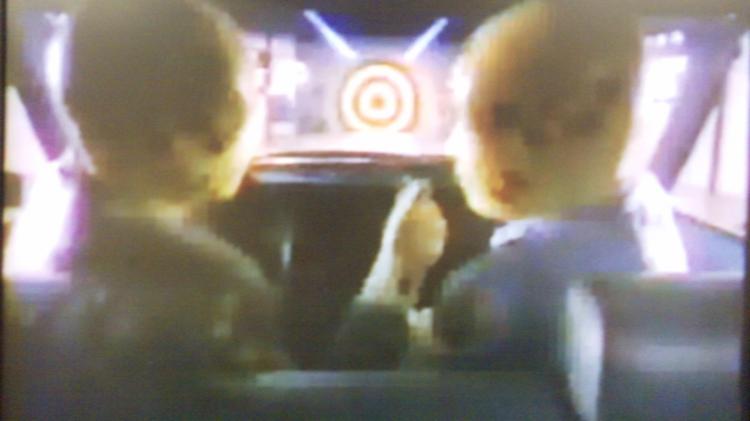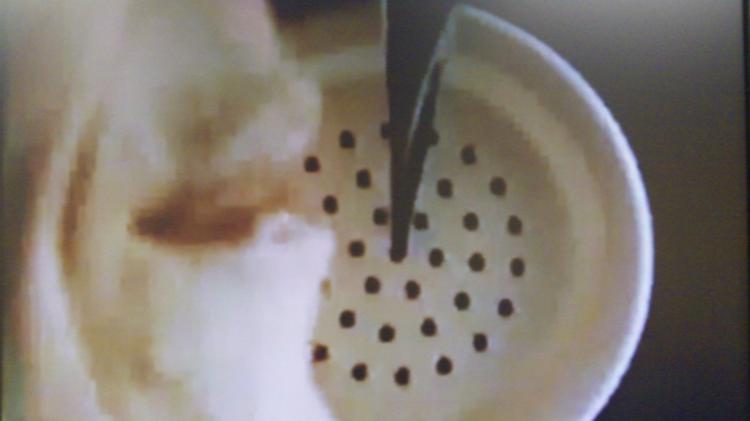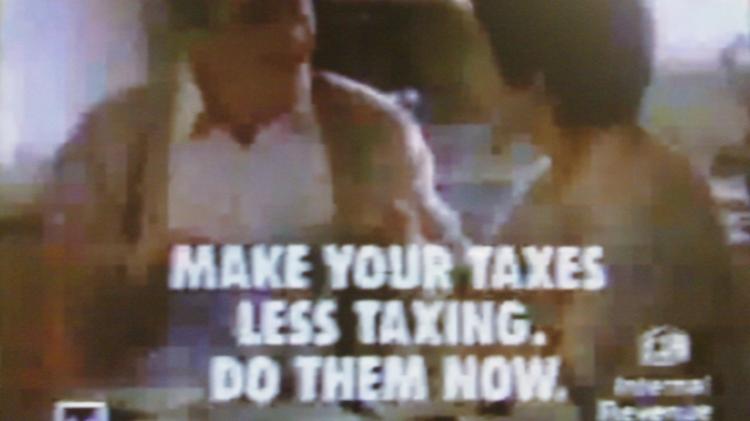Early '90s PSAs
Remembering the Ad Council. . .
Early '90s PSAs
Remembering the Ad Council. . .
Remembering the Ad Council. . .

Say what you will about George H.W. Bush, his presidency gave us a lot of interesting television. And no, I am not just talking about that time he threw up on the Prime Minister of Japan, either.
As part of the Reagan Doctrine, Dubya's daddy likewise waged a war on that bane of the 1980s, illicit street drugs. As a result, we ended up with all sorts of weird, youth targeted media, including Cartoon All Stars to the Rescue and the arcade game NARC.
The brunt end of all of this federal spending, however, went towards a program called The Partnership for a Drug Free America. If you were cognizant between the years of 1988-1992, you no doubt remember (perhaps in great detail), all of those public service announcements that warned youngsters to stay off crack cocaine and marijuana. A lot of times, these ads were a little cheesy (OK. . .EXTREMELY cheesy), and some of them were absolutely nightmare producing (Just between you and me, I still have bad dreams about the infamous Snake Drug Dealer from that one ad.) No matter how you viewed them, however, the spots were extremely memorable, even if the message itself was kind of muddied by the heavy handed delivery.
Although the late, late 80s and early, early 90s were pretty much the golden age of messed up drug public service announcements, it was also a pretty noteworthy time period for other PSA spots, too. There was an absolute DELUGE of commercials made in the 1980s and 1990s which promoted some sort of government-backed social cause, and a majority of those ads were produced by a company called the Ad Council.
The Ad Council, if you ask me, is every bit a part of our upbringing as Super Mario Bros. and the Teenage Mutant Ninja Turtles. Their work horrified, mesmerized, and inadvertently, entertained us by attempting to enlighten and inform us about the sundry social causes of the day, and even if we cannot RECALL the actual intent of the ads, we will certainly never forget the ads themselves.
Today, I would like to call your attention to some of the more memorable Ad Council spots of the late 80s and early 90s. Because, let s face it, it s been done to death, I have decided to forego reviewing any drug PSAs, if nothing else, for the sheer fact that we have already seen them and critiqued them in our latter years a million times. Instead, I want to remind you of the other ads, government programs and, in some cases, ill-fated public causes that defined our youth.

This Incredible Crash Test Dummies ad is as good a place to start as I can imagine. The Department of Transportation created the duo (if you're ever asked on Jeopardy!, their names are Larry and Vince) to encourage seat belt usage in the United States, and much to the surprise of pretty much everybody, the characters became iconic television figures of the time frame. As hard as it may be to imagine now, the spot actually inspired a Saturday morning cartoon show, a series of video games, and even a line of action figures, which were probably the only toys ever mass marketed with the GIMMICK that you could easily destroy and dismember them.

The thing I remember most about the ads, however, was that one of the Dummies was voiced by, of all people, the same voice actor that played Garfield on the popular CBS cartoon. I suppose the fact that we are watching a bunch of pun-dropping ad creations get slammed and smashed in car accidents is weird enough as it is, but hearing the voice of Peter Venkman simultaneously is one of those things that never TRULY leaves the back of your head as a child AND an adult.

Ultimately, there really was not too much meat to the ads. The two characters bicker and banter, only to end up getting mangled via some automotive related mishap or another. In this ad, the two exchange a couple of cute lines, and. . .I know, surprise, surprise. . .they end up getting thrust into a cement wall. Although I really cannot recall too much about the other ads, I assure you that the message of the commercials got to me loud and clear, since to this day, I absolutely REFUSE to stick my key into the ignition of my car until AFTER I buckle up. It may not have gotten to everybody, but it sure as heck affected me, that is for sure.

If you do not know who McGruff the Crime Dog is, you might as well buy yourself a one way plane ticket to Soviet Russia, since you clearly have nothing of value to contribute to American society.

The gist of the Crime Prevention Coalition campaign was to encourage civic involvement with local police to help curb incidents of low-level street crime. Although he is perhaps best known for hawking a mail-in comic book in the mid 90s, McGruff was the spokes mascot for the organization for a pretty long time, and in one of his earlier appearances here, it is rather apparent that the animators were still working some kinks out in his design. Honestly, he does not resemble a dog so much as he resembles a brown Falcor, which, I guess could have been the intent all the while.

So, each of these commercials involved a true life story in which a small community decided to join forces with the po-po to do some sort of civic good, like open up a garden in a destitute area or run all the drug pushers out of town. In this particular spot, entitled The Philadelphia Story, a bunch of people get together to remodel a part of the neighborhood that was vandalized with gang graffiti. Yeah, there really is not too much to dissect here, but that was kind of the whole point of the ad campaign: the police are your friends, all criminals are a bunch of no good ruffians, and most detectives are eight foot tall, anthropomorphic cartoon dogs. A tall glass of truth right there, Holmes.

Now here is a commercial that I VIVIDLY recall. Although Covenant House has become all but a distant memory (seriously, I had totally forgotten about the group until I stumbled across this ad recently), but I think we are all familiar with their concept. Covenant House was sort of a halfway house for runaway teens - imagine, if you will, a female version of Boys Town - and this spot was EFFECTIVE to the Nth degree in getting the point across that being a homeless 14 year old SUCKED.

This ad uses a super simple, albeit super effective, way to garner your attention. It involves a young woman hanging out in an alley, totally silent. Then, a voice over begins, which I guess is supposed to be her internal thoughts, which slowly transmogrifies from being sad to downright hysterical. Really, it is just about the easiest damn thing in the world to pull off as an ad-man, but boy, is it ever successful in giving you the heebie-jeebies.

The effectuality of the Covenant House ads - and by the same logic, all of the Boys Town ads, as well - rest in the fact that I really did not KNOW that Covenant House was a place people could VOLUNTARILY stay. Up until I was about seven, I thought Boys Town was basically a place were irresponsible and reckless youngsters were shipped off, against their will, and forced to live like savages a la Lord of the Flies. Comparatively, I simply assumed that Covenant House was a place your parents could mail you to if you did not get good grades and clean your room, so every time I saw this ad, it, understandably, always freaked me out a bit.

As an adult, the one thing I wonder about while watching these commercials is what sorts of OTHER advertising firms did some of the people that made these ads work for. I guess that if you are in the field of marketing, you go from one firm to the other without really asking any questions, but even so, I wonder just how in the bluest of hells someone can switch gears from making commercial like this to producing a spot for Diet Pepsi.

Now, lingering on a commercial for the National Child Abuse Prevention Hotline is something NOBDOY wants to do, but as a simple media analysis, I would advise going out of your way to catch this commercial. Granted, it is pretty reserved and hokey (yeah, calling someone a brat is SO 1990), but it manages to get the point across with such ease that it is kind of awe inspiring, even now. I do not even think you need to understand English to get the point of this spot: when parents say bad things about their kids, those kids feel crappy about themselves.

Such a simple idea, such a simple delivery, and man, is it executed ever so masterfully here.

In the early 90s, no doubt inspired by the Exxon Valdez disaster a year earlier, the whole environmental movement really went into overdrive. In a year s time, we d finally have Captain Planet on TV, but in the meantime, we had this pretty clever (and let s face it, freaky) ad to tide us over.

A lot of these PSAs incorporate twist endings to drive the point of the organization home. Trust me, you will be saying more than one of these today. Perhaps inspired by Planet of the Apes, this ad likewise decides to throw the viewer for a loop, by showcasing a singing choir of children, belting out a rendition of America the Beautiful. . .

. . .in a GARBAGE HEAP. Get it, because Americans like to litter and we produce an inordinate amount of garbage per person compared to other nations in the world? I suppose the point of the Environmental Defense Fund ad got made, but this one never really stuck with me throughout the years the same way a lot of these other commercials did. Yeah, I never thought I would be saying that a public service announcement was too subtle, either.

Although we were probably too young or disinterested to care, 1990 was a really important year for legal affairs in the U.S., since it was the year the Americans with Disabilities Act took effect. That s right, Millennials - those handicapped parking spaces have not been around forever, believe it or not.

The gist of this ad, which was in support of the American Mental Health Fund, had a pretty simple intention: to get people to understand that citizens with mental disorders were actually pretty harmless individuals. The ad begins with about ten seconds of flashing quick cuts, which contains stock footage of people in loony bins and fake newspaper headlines about psychos on the loose. Then, the narrator (who I think is Alec Baldwin, but do not hold me to it) tells the viewers at home that quote en quote crazy people really are not dangerous at all.

Of course, that message really did not come across to a five year old, so I remember being piss-panted scared by the ad. I guess older kids would have gotten it with no problem, but you really are expecting too much out of a kindergartner to see the word psycho killer on a TV screen without getting a little anxious. There is no doubt that the intention of the spot was good, but to a wee little kid, it pretty much made the INVERSE impact on me, as every time this commercial aired, I felt the need to double check the padlock to make sure no escaped mental patients had the opportunity to barge into my living room.

As part of the growing up experience, our minds often physiologically (as in, NOT psychologically) displace information by the process of brain cell replacements. Sure, our more vivid memories of childhood are stored in our hippocampus (Google it) and can be easily recalled, but over time, we lose a lot of details, which are ultimately filtered out of our amygdala (Google that, too). Every now and then, however, we stumble upon something that reaches WAYYYY back into our memory banks and yanks out an image that we have not dwelled upon in decades, and for me, this ad is PRECISELY such an experience.

Honestly, I have no idea who or what the Independent Sector was, but somehow, I managed to remember this commercial. For what it is worth, it does have a pretty neat gimmick - in order to get people to volunteer five hours and five percent of their salaries a week to charitable causes, this ad shows an array of common household objects with five percent missing from each item. We see a phone, a CD, a baseball, so on and so forth - which, to be fair, is pretty memorable as a visual aid.

The misstep the Ad Council made here, of course, is that there is pretty much no way in hell anyone is going to remember the name of the organization the commercial itself is for. Sure, the whole five percent shtick is kind of cute, but when it was all said and done, we could not correlate what that five percent was supposed to be a reference to. I am not sure if the Independent Sector is still around, but I kind of doubt that it is. . .I mean, altruism is cool and all, but when you fail to create brand name appeal through your ads, you pretty much know how your cause is going to play out for the other 95 percent of the population.

A lot of these old school PSAs used the old misdirection technique. Take this ad, for example, which begins with the disembodied announcer listing facts about a number of knives. So, this one has to be about gang violence or kitchen safety, right?

Well, as it turns out. . .not so much, as the ad is actually about the dangers of eating too much fatty foods. After showcasing a couple of military caliber stabbing weapons, the announcer tells us that the ordinary butter knife is probably the most dangerous utensil in the world, before a message flashes on screen encouraging viewers to eat more lean meats.

The ad was actually paid for by the Kaiser Foundation. . .you know, those same guys that run Kaiser-Permanente. Apparently, those life insurance folks know something about fried pork chops that we do not, as they make it a MAJOR issue to expound upon the lethality of eating high fat content. As before, the actual message of the commercial never really resonated with me, as I took the visuals of the ad literally, thusly avoiding (and when applicable, telling my friends about avoiding) using kitchen knives, because some guy on TV told me they were deadlier than machetes. No, I was not an impressionable youth or anything. . .

Even if you were not around in the late 80s and early 90s, TV conditioning pretty much PRIMES you into instantly knowing something B-A-D is going to happen whenever imagery of a rainforest is shown on the tube. Here, we have a Pacific northwest-looking timberland, in all of its glorious, natural majesty.

Of course, that means that the REST of the ad contains images of burning forests. I really do not know what it is, but fire seems to ALWAYS freak out little kids - I can only IMAGINE the amount of trauma this commercial had to have given you if you had your house burn down as a child.

Yeah, you really do not need me to tell you that this was an ad by the U.S. Forest Service. Even if you know next to nothing about U.S. commercial culture, you have surely run across Smokey Bear (not Smokey THE Bear as a lot of uninformed folks will tell you) before, so I am not going to insult your intelligence by giving you a lecture about who and what he is. . .although I do hear that the U.K. equivalent, Smackey the Frog, is a far more beloved PSA mascot.

The final commercial I will spotlight in this whirlwind (and totally NOT AT ALL random) tour of PSAs from twenty years ago is an ad that, once again, uses misdirection to fool the viewer into believing he or she is receiving a message about something TOTALLY unrelated to the actual message of the spot. Let s see if you can figure out what this enigmatic ad is about BEFORE the big, twist ending is revealed.

So, the commercial begins during a dark, dreary rainstorm. It is lightning like crazy, and a very confused, very frightened middle aged man is apparently seeking shelter from. . .something. The camera pans toward his face as a flash of lightning explodes in the foreground. He looks up at the camera, and the look on his face is one of absolute, unmistakable terror. He lets out a silent scream, as SOMETHING off screen is staring him right in the face. My oh my, what unfathomable horror could this ad be about?

SWERVE! As it turns out, the whole ad took place in dream world, and the entire nightmare was a metaphor for being unable to understand the tax code. Granted, the Internal Revenue Service often produces a lot of unease for people around April, but I think this commercial, which made filing a W-2 out to be like something out of a bad Stephen King adaptation, may be overstating the sensation just a bit.
And that, in a nutshell, was what you missed out on in the George H W Bush years. All in all, there were literally hundreds of Ad Council spots produced in the timeframe, and I am sure we all have our own personal favorites. All in all, these things were hokey, corny, and in most cases, flat out propaganda, but you know what? It is hokey, corny propaganda that is highly memorable for us Reagan babies. One of the things you really cannot replicate for this article is the sensation of catching these spots during your favorite afternoon cartoon series, thus giving you this WEIRD, contradictory mish-mash of the fantastical and the all-too-real. One minute, you were watching The Rat King and Shredder, and in the next, you were being told that if you did drugs or drove drunk, you would get eaten by skeletons or have your foot amputated. Surely, there is some AMAZING stuff out there that was produced by the Ad Council, and if you are having an atypically boring afternoon, I would not vote against searching the YouTube for a couple of old PSAs. Granted, it is one of the WEIRDER walks down memory lane you can take, but one that ought to get your nostalgic recollections flowing like crazy.
So, what PSAs from your childhood do YOU have vivid memories about?


. . .in a GARBAGE HEAP. Get it, because Americans like to litter and we produce an inordinate amount of garbage per person compared to other nations in the world? I suppose the point of the Environmental Defense Fund ad got made, but this one never really stuck with me throughout the years the same way a lot of these other commercials did. Yeah, I never thought I would be saying that a public service announcement was too subtle, either.

Although we were probably too young or disinterested to care, 1990 was a really important year for legal affairs in the U.S., since it was the year the Americans with Disabilities Act took effect. That s right, Millennials - those handicapped parking spaces have not been around forever, believe it or not.

The gist of this ad, which was in support of the American Mental Health Fund, had a pretty simple intention: to get people to understand that citizens with mental disorders were actually pretty harmless individuals. The ad begins with about ten seconds of flashing quick cuts, which contains stock footage of people in loony bins and fake newspaper headlines about psychos on the loose. Then, the narrator (who I think is Alec Baldwin, but do not hold me to it) tells the viewers at home that quote en quote crazy people really are not dangerous at all.

Of course, that message really did not come across to a five year old, so I remember being piss-panted scared by the ad. I guess older kids would have gotten it with no problem, but you really are expecting too much out of a kindergartner to see the word psycho killer on a TV screen without getting a little anxious. There is no doubt that the intention of the spot was good, but to a wee little kid, it pretty much made the INVERSE impact on me, as every time this commercial aired, I felt the need to double check the padlock to make sure no escaped mental patients had the opportunity to barge into my living room.

As part of the growing up experience, our minds often physiologically (as in, NOT psychologically) displace information by the process of brain cell replacements. Sure, our more vivid memories of childhood are stored in our hippocampus (Google it) and can be easily recalled, but over time, we lose a lot of details, which are ultimately filtered out of our amygdala (Google that, too). Every now and then, however, we stumble upon something that reaches WAYYYY back into our memory banks and yanks out an image that we have not dwelled upon in decades, and for me, this ad is PRECISELY such an experience.

Honestly, I have no idea who or what the Independent Sector was, but somehow, I managed to remember this commercial. For what it is worth, it does have a pretty neat gimmick - in order to get people to volunteer five hours and five percent of their salaries a week to charitable causes, this ad shows an array of common household objects with five percent missing from each item. We see a phone, a CD, a baseball, so on and so forth - which, to be fair, is pretty memorable as a visual aid.

The misstep the Ad Council made here, of course, is that there is pretty much no way in hell anyone is going to remember the name of the organization the commercial itself is for. Sure, the whole five percent shtick is kind of cute, but when it was all said and done, we could not correlate what that five percent was supposed to be a reference to. I am not sure if the Independent Sector is still around, but I kind of doubt that it is. . .I mean, altruism is cool and all, but when you fail to create brand name appeal through your ads, you pretty much know how your cause is going to play out for the other 95 percent of the population.

A lot of these old school PSAs used the old misdirection technique. Take this ad, for example, which begins with the disembodied announcer listing facts about a number of knives. So, this one has to be about gang violence or kitchen safety, right?

Well, as it turns out. . .not so much, as the ad is actually about the dangers of eating too much fatty foods. After showcasing a couple of military caliber stabbing weapons, the announcer tells us that the ordinary butter knife is probably the most dangerous utensil in the world, before a message flashes on screen encouraging viewers to eat more lean meats.

The ad was actually paid for by the Kaiser Foundation. . .you know, those same guys that run Kaiser-Permanente. Apparently, those life insurance folks know something about fried pork chops that we do not, as they make it a MAJOR issue to expound upon the lethality of eating high fat content. As before, the actual message of the commercial never really resonated with me, as I took the visuals of the ad literally, thusly avoiding (and when applicable, telling my friends about avoiding) using kitchen knives, because some guy on TV told me they were deadlier than machetes. No, I was not an impressionable youth or anything. . .

Even if you were not around in the late 80s and early 90s, TV conditioning pretty much PRIMES you into instantly knowing something B-A-D is going to happen whenever imagery of a rainforest is shown on the tube. Here, we have a Pacific northwest-looking timberland, in all of its glorious, natural majesty.

Of course, that means that the REST of the ad contains images of burning forests. I really do not know what it is, but fire seems to ALWAYS freak out little kids - I can only IMAGINE the amount of trauma this commercial had to have given you if you had your house burn down as a child.

Yeah, you really do not need me to tell you that this was an ad by the U.S. Forest Service. Even if you know next to nothing about U.S. commercial culture, you have surely run across Smokey Bear (not Smokey THE Bear as a lot of uninformed folks will tell you) before, so I am not going to insult your intelligence by giving you a lecture about who and what he is. . .although I do hear that the U.K. equivalent, Smackey the Frog, is a far more beloved PSA mascot.

The final commercial I will spotlight in this whirlwind (and totally NOT AT ALL random) tour of PSAs from twenty years ago is an ad that, once again, uses misdirection to fool the viewer into believing he or she is receiving a message about something TOTALLY unrelated to the actual message of the spot. Let s see if you can figure out what this enigmatic ad is about BEFORE the big, twist ending is revealed.

So, the commercial begins during a dark, dreary rainstorm. It is lightning like crazy, and a very confused, very frightened middle aged man is apparently seeking shelter from. . .something. The camera pans toward his face as a flash of lightning explodes in the foreground. He looks up at the camera, and the look on his face is one of absolute, unmistakable terror. He lets out a silent scream, as SOMETHING off screen is staring him right in the face. My oh my, what unfathomable horror could this ad be about?

SWERVE! As it turns out, the whole ad took place in dream world, and the entire nightmare was a metaphor for being unable to understand the tax code. Granted, the Internal Revenue Service often produces a lot of unease for people around April, but I think this commercial, which made filing a W-2 out to be like something out of a bad Stephen King adaptation, may be overstating the sensation just a bit.
And that, in a nutshell, was what you missed out on in the George H W Bush years. All in all, there were literally hundreds of Ad Council spots produced in the timeframe, and I am sure we all have our own personal favorites. All in all, these things were hokey, corny, and in most cases, flat out propaganda, but you know what? It is hokey, corny propaganda that is highly memorable for us Reagan babies. One of the things you really cannot replicate for this article is the sensation of catching these spots during your favorite afternoon cartoon series, thus giving you this WEIRD, contradictory mish-mash of the fantastical and the all-too-real. One minute, you were watching The Rat King and Shredder, and in the next, you were being told that if you did drugs or drove drunk, you would get eaten by skeletons or have your foot amputated. Surely, there is some AMAZING stuff out there that was produced by the Ad Council, and if you are having an atypically boring afternoon, I would not vote against searching the YouTube for a couple of old PSAs. Granted, it is one of the WEIRDER walks down memory lane you can take, but one that ought to get your nostalgic recollections flowing like crazy.
So, what PSAs from your childhood do YOU have vivid memories about?

19
Login To Vote!
More Articles From JSwiftX







